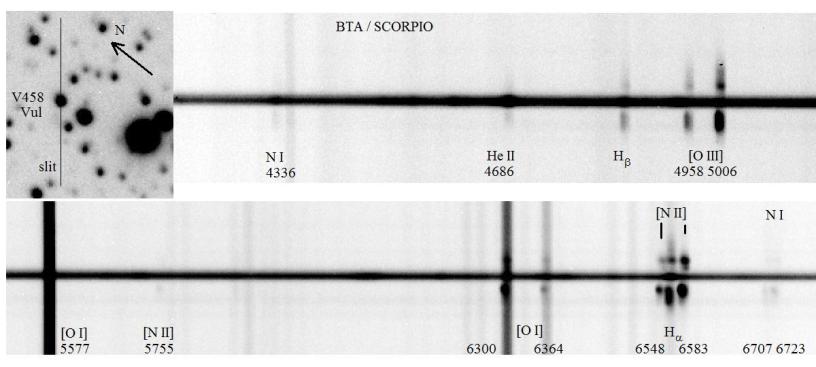Bipolar gas outflow from the nova V458 Vul
V.P. Goranskij (SAI, Moscow University), E.A. Barsukova and T.A. Fatkhullin
(Special Astrophysical Observatory, Russia)
Published in Astronomer's Telegram No.2670.
Classical nova V458 Vul (N Vul 2007 No.1) was detected as a supersoft
X-ray source by the Swift XRT (ATel#1246, #1603). This star is interesting
with its spectral class change: features of Fe II class nova completely
changed by features of He/N class in the SSS phase (T.N. Tarasova,
IBVS #5807).
We performed spectral observations of V458 Vul with the Russian 6-m
telescope BTA and spectral camera SCORPIO on 2010 June 9.84 UT.
The exposure was 1200 s. The spectrum was taken in the long-slit mode
with the resolution FWHM 15 A in the wavelength range 3100-7300 A.
The position angle of the slit was 135 degrees. In such
position, bright knots of nebulosity are visible in the slit in the
monochromatic light of different spectral lines at both
sides from the stellar spectrum at the distance of 3".6 to NW and 4".3 to
SE from the star. The SE knots are brighter in all the lines. There are
also faint knots seen in some lines, and scattered radiation.
In Balmer lines, the structure expands by 27".5 along the slit.
In addition to Balmer lines, we identified nebulosity in He II 4686 A,
[O I] 6300 and 6363 A, [O II] 7319 A, [O III] 4958, 5006 A, N I 6708,
6723 A, [N II] 5754, 6548, 6583 A, and N IV 7129 A.

Fig. 1.
Fragments of direct BTA/SCORPIO image and spectrum taken on
2010 June 9. In the image, the location of slit is shown by vertical
line.
On the next night, we have taken direct CCD images of V458 Vul with UBVR_c
filters with the SAO 1-m Zeiss reflector. The seeing was 1".4.
In the R band frame taken in June 10.92 UT with the exposure 420 s,
faint jet-like structure is seen at p.a. 125 degrees and in the
opposite direction. The location of the structure turned out close
to position of spectrograph slit accidentally.

Fig. 2.
Fragment of SAO 1-m Zeiss direct R band image taken on
2010 June 10. Bipolar jet-like feature is shown by lines.
Remark.
Dr. Albert Zijlstra (JBCA, Univ. of Manchester) writes that this
nebula described in detail by Wesson et al. 2008, ApJ V.688, L21.
The extended nebula was found in Halpha images obtained 6 weeks before
the outburst as part of the IPHAS Galactic plane survey. The authors
describe this object as a planetary nebula connected with the
progenitor. An inner knot of nebula
increased rapidly in brightness due to flash ionization by nova event.
They identified the double emission line near 6723 A as a [S II] lines
at 6716 and 6723 A.
Possible orbital period. Spectrum
development.


